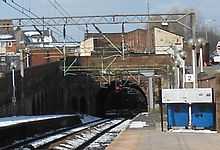Daylighting (tunnels)
Daylighting a tunnel is to remove its "roof" or overlying rock and soil, thus exposing the railway or roadway to daylight. This could also be seen as converting the tunnel to a railway or roadway cut. Tunnels are often daylighted to improve vertical or horizontal clearances, for example to accommodate double-stack container trains or electrifying rail lines, where increasing the size of the tunnel bore would be impractical.
List of daylighted tunnels
- This list is incomplete; you can help by expanding it.
- United Kingdom
- Lime Street Station in Liverpool was originally approached through a 1.13-mile (1.82 km) twin-track tunnel completed in 1836. The tunnel was daylighted in the 1880s, and replaced with a deep four-track cutting, with only the eastern 50 metres (55 yd) approaching Edge Hill railway station remaining as a tunnel.

The short remaining portion of Liverpool's Lime Street Station tunnel can be seen west of Edge Hill Station.
- United States of America
- Auburn Tunnel on the Schuylkill Canal, daylighted in 1857
- Tunnel No. 5 on the Alaska Railroad's Seward-Anchorage line[1]
- Tunnel No. 5 on the Virginia & Truckee Railroad at Nevada S.R. 341 near Virginia City
- The Gwynedd Cut on the North Pennsylvania Railroad, near North Wales, Pennsylvania, built as a tunnel between 1853 and 1856, daylighted in 1930 when the Reading Railroad electrified the line
- A number of tunnels were open cut for the National Gateway project including:
- Shoo Fly Tunnel (2012)
- Pinkerton Tunnel (2012)
- Bedford Tunnel (2012)
References
- ↑ F. C. Weeks et al., "Tunnel 'Daylighting' on the Alaska Railroad," Transportation Research Record No. 1119, Geotechnology (1987).